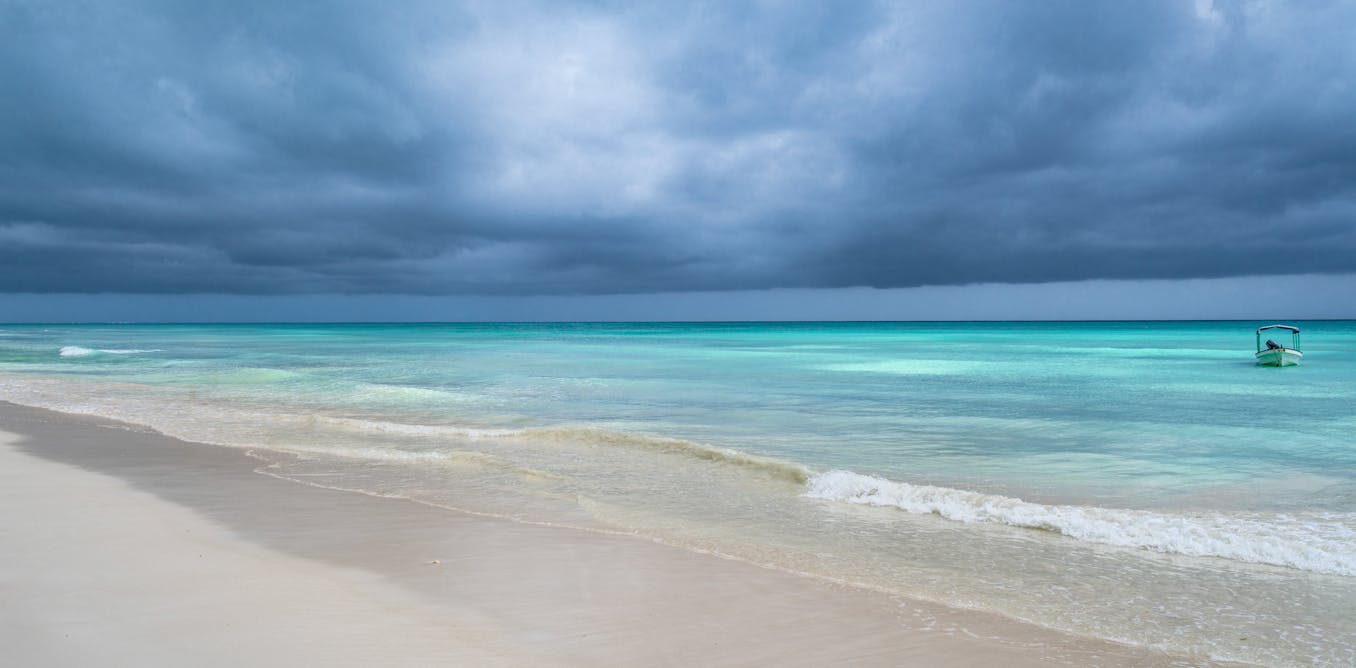“I think it’s one of the best feelings, euphoria,” says Sara Landry. “Like, I just like that type of feeling.”
One might have already assumed as much prior to meeting Landry, whose throttling, physical, psychospiritual live sets have made her one of the buzziest names of the current dance music moment.
Today she shows up on Zoom bathed in the dim glow of an off-camera light source. Other interviews she’s done have mentioned her being cast in a green gleam; this afternoon, it’s magenta. Either way, the effect contributes to the witchy and so-called “high priestess of hard techno” persona the American-born, Netherlands-based producer has developed, although the veil is kind of pierced when a delivery guy rings the doorbell of her place in Amsterdam.
“I’ve gotta step over my pilates machine that’s buried in clothes because I’m trying to clean out the closet,” Landry says, laughing as she maneuvers back to the camera after grabbing a package containing new stage outfits. “It’s been a long summer.”
A long 14 months, even. While Landry has been in the scene for a decade with singles and EPs dating back to 2018, she was thrust into the zeitgeist in August of 2023, when her Boiler Room set created, she says, “a wave of momentum.” This wave has turned tidal as she’s bounced across continents playing increasingly larger shows.
With it all, Landry is making “hard techno” — a genre that’s existed largely in the underground and at festival side stages since developing in Northern Europe in the early ’90s — a dark horse entry in the mainstream live dance music market. Landry made her EDC Las Vegas debut in June and in July became the first hard techno artist to play the Tomorrowland mainstage in the festival’s nearly 20-year history. She’s sold out every show she’s played in the U.S. this year, closed out Portola festival in San Francisco last month, released her wild-eyed debut album Spiritual Driveby in early October and last week announced a series of headlining shows, called Eternalism, which will happen across Europe in early 2025. A press release calls these shows not just a tour, but “a spiritual gathering, a testament to the power of collective energies.”
That might be true, and certainly Landry has developed a potent brand around her techno witch sensibilities. The success she’s found, as she tells it, is a function of “settling into this comfortable knowledge of what my vibe is,” with that vibe essentially being a hybrid of hard techno and the meditation/sound bath realm of spirituality wrapped up in black bodycon and heavy eyeliner. This identity, while compelling, on its own wouldn’t be enough to sustain, but Landry has the music to both back it up and make it all feel less like a put on and more like a natural extension of her interests and artistry.
Born in the Bay Area and raised in Austin, Texas, Landry got into clubbing and dance music while a student at NYU, where she earned degree in finance, psychology and advertising — areas undeniably applicable to succeeding as a DJ. After college, she worked as a data analyst in Austin while teaching Ableton courses, throwing parties around town and livestreaming through the pandemic. After meeting agents Bailey Greenwood and Annie Chung backstage at a festival, she signed with WME for representation in North America in 2022, with her growing presence neatly coinciding with an increased appetite for dark, pummeling, sort of apocalyptic but also kind of chic music in the North American scene. (See also: the success of Tale of Us’ Afterlife brand and Anyma’s upcoming residency at Sphere.)
The general assessment among many, Landry included, is that in these hard times, people want commensurately hard music and a place, she says, for “high energy, high octane experiences” where they can forget out the wars, the election, climate change and other varieties of doom and just tap into their reptilian brain for a few hours. Of course dance music has existed as an escape since its origins, with mainstream EDM offering this same space and freedom to the masses not by acknowledging bad things in the world but by pumping out feel-good anthems that made it possible to momentarily pretend they weren’t there. Now, the scene is in a place where heavy sounds are embraced because reality is no longer so easy to ignore.
But also, TikTok. Beyond existential angst, social media primed the metaphorical pump for Landry and other young artists making heavy styles of music. “With hard techno specifically, social media has been a huge factor in making it more accessible for people to discover new sounds and find their community,” Greenwood and Chung say in a joint statement, continuing that after the pandemic “people were hungry for new energy and seeing clips from these events circulate made them want to go out and participate.”
The agents agree that dance music is having a major moment in the U.S., “but this time we are seeing different genres that were historically deemed ‘underground; get pushed to the forefront of the scene and come together in new inventive ways,” a phenomenon they say has made space for new artists like Landry while giving a platform to veterans who’ve been making this type of music for a long time.
Being American has also helped Landry, given that she can canvass the market more than international acts with similar sounds who aren’t able to tour here as often. “Her team saw the value of investing in smaller markets and really laid the groundwork throughout the country,” Greenwood and Chung say. “Our first few runs in the country were really deep dives that brought the sound to corners of the U.S. that often get overlooked, long before this sound exploded here.” To wit, in June Landry was the first hard techno artist to ever headline at The Caverns in Pelham, TN, with two sold-out shows. (Landry is repped by CAA in Europe.)
While she considers herself a member of the “second wave of electronic music that’s really punching through and breaking into the mainstream,” (a category one could also slot in new stars like John SUmmit, Dom Dolla and Mau P in) Landry doesn’t foresee her music charting like the mainstream crossover dance of the 2010s. “My goal has never really been radio,” she says.
Indeed Spiritual Driveby isn’t really top 40 material. Its 12 tracks fuse hard techno foundations (heavy kickdrum, rumble, sidechain, BPMS ranging between 140 and 160) with trance-like chants, spoken word lyrics about devotion and giddy rhymes about sex. Released on her own Hekate Records (which is named for the Greek goddess of the underworld and also releases music by rising acts), the album features collaborators including Mike Dean, who worked on the album-closing title track. Her catalog has 50.9 million official global on-demand streams, according to Luminate.
“I’ve been taking elements of kind of whatever I want and just putting it on a hard techno chassis,” Landry says of her approach, “where the drums, the arrangement and the grooves are rooted in that, especially the kick drum. but then I kind of do whatever I want on top of it.”
“Whatever I want” can include adding elements of psytrance, chanting and little injections of pop. Working in samples of music by artists like M.I.A. and Nickelback “scratches a little part of my brain,” Landry says. Not everyone is a fan, with a certain number of techno purists side-eyeing the style, a generally predictable turn of events that follows the tradition of many veteran dance scenesters hating on new styles that lean into pop and generally commercialize underground sounds and scenes. (See: basically the entire EDM era.)
“I find myself wanting to do things that are a bit more commercial than what a lot of people, especially people who’ve been in the techno scene for 20-plus years, may think techno can be,” says Landry. “A lot of that stuff is tongue in cheek, but I think it’s just fun. I feel like parties are supposed to be fun.”
But she also acknowledges that people are naturally protective of underground spaces and resistant to throngs of newcomers in techno cosplay who might threaten it.
“Especially when you get into the underground scene, I think a lot of people love the music, but there’s also this social construct of value,” she says. “People are like, ‘I’m cool for knowing about this and liking this, and I want to remain here and be cool with my cool little clique and my identity that I’ve constructed for myself, where I’m so much cooler than everybody else.’ People want to gatekeep, because they want to protect the space that they feel cool and underground for knowing about. But with the invention of social media, everybody has access to everything all the time, which is a blessing and a curse.”
“I understand why people get upset,” she continues, “because I imagine it feels a bit like a loss of identity. If everybody thinks this thing I think is cool that I based a good chunk of my personality around, then am I a unique person? Do I have any unique experiences? I can understand how that inspires stressful thoughts that cause people to lash out.”
While she will defend people being attacked in the dance culture war crossfire, she also doesn’t really have a lot of time to dwell on it. She’s touring heavily in the U.S., South America, Asia, Australia and Europe through the end of the year, with her Eternalism performances starting in late January in Amsterdam. Her team plans to bring this production around the world. “We’re really only seeing the beginning of where she can go,” Greenwood and Chung say.
In the meantime, here on Zoom in the magenta glow, Landry demonstrates that euphoria can be subtler than percussion shaking the walls of any given sold-out venue.
“It feels like the end of the first cycle,” she says of where things are for her today. “The first cycle of your career is working very hard to get to a point where you’re like, ‘Oh, I’ve done it. I’ve done what I set out to do so far.’ The place I’ve always hoped I could get? I’m in that place.”

The post “Tough Times, Hard Techno: Inside the Rise of Sara Landry” by Katie Bain was published on 10/29/2024 by www.billboard.com







































Leave a Reply